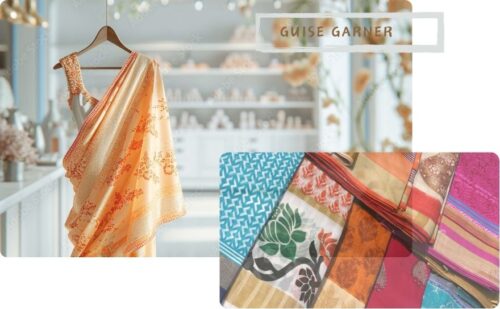Fabric Printing: A Comprehensive Guide to a Vibrant World of Design
“Fabric printing is the artistry that brings imagination to life, transforming a blank canvas of fabric into a vibrant tapestry of colors and patterns, weaving stories that touch our senses and wrap us in the embrace of creativity.”
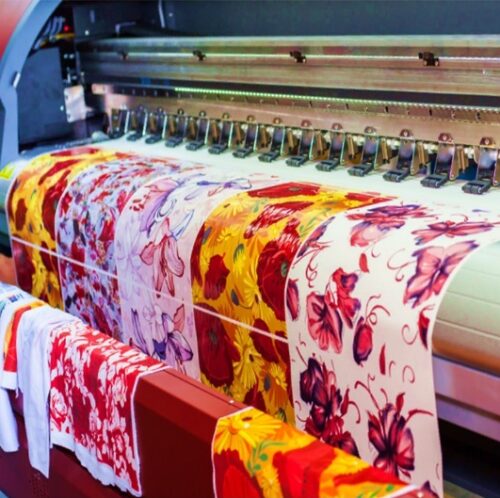
It is an art form that has been practiced for centuries, allowing individuals to express their creativity and bring life to textiles. In this article, we will explore the world of fabric printing, from its rich history to modern-day applications and techniques. So, let’s dive into this colorful journey!
Introduction to Fabric Printing
This fascinating technique involves transferring designs, patterns, or images onto fabric using various printing methods. This is the most popular process of transferring designs onto fabric surfaces, allowing individuals to create customized and unique textiles. It adds a personal touch to garments, home decor items, and various other fabric-based products. With fabric printing, one can transform plain fabrics into eye-catching pieces of art, reflecting individual style and creativity.
Historical Significance
Fabric printing has a rich historical background that dates back to ancient times. The art of printing on fabric originated in China around the 4th and 5th century BC. It then spread to other regions, such as India, Persia, and Europe, where different cultures developed their unique printing techniques. These traditional methods have influenced contemporary fabric printing practices.
During the early 17th century, the East India Company initiated the transportation of printed cotton to England. Subsequently, in the 18th century, a printing method utilizing rollers or cylinders came into existence.
Additionally, the 20th century witnessed the emergence of the contemporary silk-screen printing technique. During the mid-20th century, the introduction of multi-color rotary screen-printing facilitated large-scale and faster production, resulting in improved cost-effectiveness.
Popular Fabric Printing Techniques
Fabric printing techniques have evolved over time, incorporating traditional and modern methods. Let’s explore three popular techniques used today:
Block/Stamp Printing
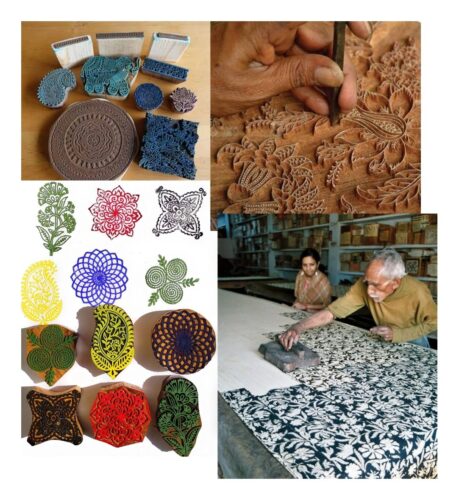
Block printing – A Heritage Craft is the first printing method that is originated from China. Block or stamp printing is a traditional form of printing that involves carving a design onto a block or stamp. The design is typically raised on the block, while the surrounding areas are carved away to create a relief. Ink is applied to the raised surface, and the block is pressed onto the desired material, such as fabric, paper, or clay. The pressure transfers the ink onto the material, creating a print of the carved design.
The printing allows for intricate and repeatable patterns, and it is often used for creating textiles, decorative papers, stationery, and artwork. It has a rich history and is practiced in various cultures around the world. This is a hard and slow process so it is typically nor preferred for High volume comercial use.
Types
- Woodblock Printing
- Linoleum Block Printing
- Rubber Block Printing
Screen Printing

Screen printing is a popular printing technique that involves using a mesh screen to transfer ink onto a surface. The screen is prepared by creating a stencil, blocking certain areas to prevent ink passage. The screen attaches the stencil, and applies ink to the unblocked areas.A squeegee is then used to push the ink through the screen, creating a print on the desired surface below. Screen printing is versatile and can be used on various materials such as fabric, paper, plastic, and metal. It is commonly used for printing designs on T-shirts, posters, signage, and promotional items.
Types
- Traditional Screen Printing
- Rotary Screen Printing
- Flatbed Screen Printing
Roller Printing
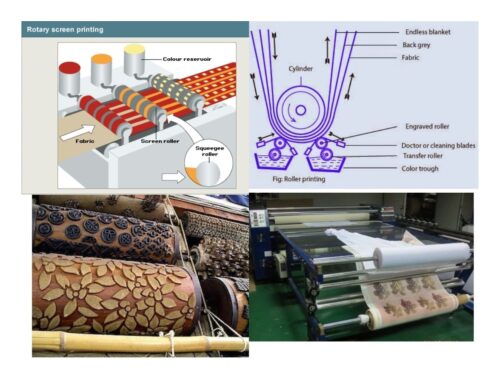
Roller printing is a conventional textile printing technique that uses engraved rollers to apply color and patterns onto fabric. The process involves feeding the fabric through a machine, where ink is transferred from the rotating engraved rollers onto the fabric’s surface. It enables fast and precise mass production of printed fabrics, particularly on natural fibers like cotton and silk. However, roller printing has limitations in terms of design versatility and customization compared to digital printing methods. While it is efficient for large-scale production, it may not be as suitable for small-scale or customized printing requirements.
Transfer Printing
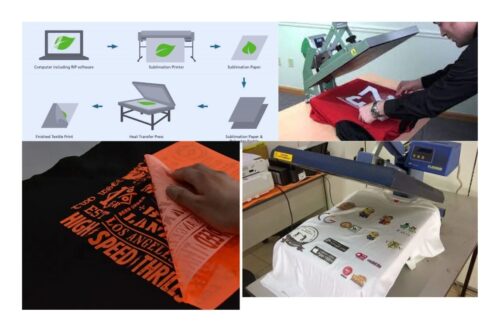
Heat transfer printing is a process that uses heat to transfer a design or image onto a substrate. It involves a special type of paper, called transfer paper, which is printed with the desired design using heat-resistant inks. To apply heat, one places the transfer paper face-down onto the substrate, such as fabric or ceramic, using a heat press machine. The heat causes the ink on the transfer paper to liquefy and adhere to the substrate, creating a permanent and vibrant print. Custom apparel, promotional items, and personalized gifts commonly utilize this in their production.
Types
- Heat Transfer Printing
- Vinyl Transfer Printing
- Sublimation Transfer Printing
Burn Out Printing
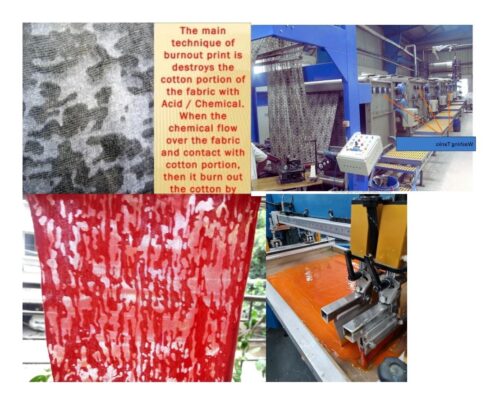
Burnout printing, also known as devoré printing, is a technique used to create intricate and textured designs on fabrics. It involves selectively removing or “burning out” certain fibers from a fabric blend to create a pattern or design. The process typically involves applying a chemical paste or gel to the fabric, which dissolves the desired fibers when heated. This creates a semi-transparent effect, with the remaining fibers forming the design. Burnout printing allows for the creation of unique and visually appealing patterns, adding depth and texture to fabrics. It is commonly used in fashion and textile industries for creating distinctive garments and accessories.
Discharge Printing
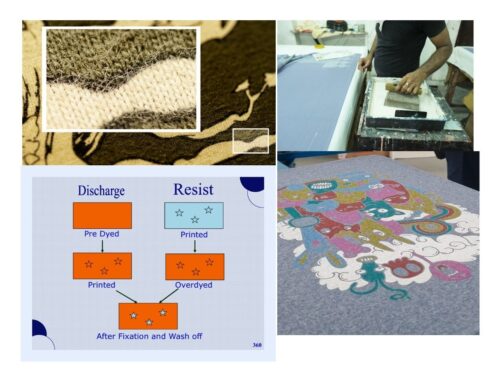
Discharge printing is a textile printing technique that involves removing color from fabric instead of adding new colors. A discharge agent is applied to the fabric in a desired design, which breaks down and removes the existing dye. The fabric is then heated to activate the discharge agent, and subsequently washed to remove any residue. This process creates soft, breathable prints with a natural appearance. Discharge printing is often used on dark fabrics to reveal lighter tones, but it can also be applied to light-colored fabrics for a subtle effect. It’s a popular choice for creating unique designs with a soft feel.
Types
- Thiox Printing
- Bleach Printing
- Block Discharge Printing
Digital Printing
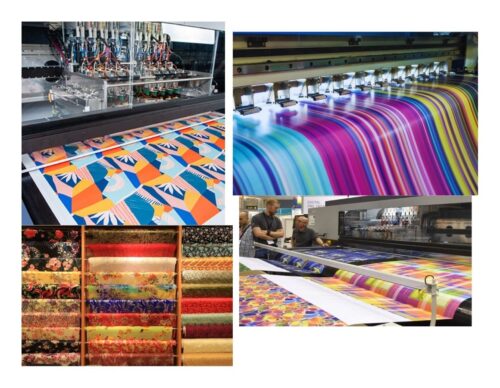
Digital printing is a modern printing method that involves transferring digital images directly onto various surfaces. Unlike traditional printing methods, digital printing eliminates the need for physical printing plates or screens. The process typically involves sending digital files directly to a printer, which then reproduces the image by spraying tiny droplets of ink onto the surface. This method offers flexibility and high-quality results, allowing for customization and quick turnaround times. Commercial printing widely uses digital printing for items such as brochures, business cards, labels, and packaging. It is also used in textile printing, signage, and art reproduction.
Types
- Direct-to-Garment (DTG) Printing
- Reactive Inkjet Printing
- Pigment Inkjet Printing
- Sublimation Printing
These are just a few examples of the many textile printing techniques used in the industry. Each method offers unique advantages and can be used to achieve different effects and styles in textile designs.
Other Popular Printing Methods
Here is the final list of fabric printing methods:
- Resist Printing:
- Batik Printing
- Shibori Printing
- Wax Resist Printing
2. Tie-Dye:
- Traditional Tie-Dye
- Ice Dyeing
- Shibori Tie-Dye
3. Stencil Printing:
- Freehand Stencil Printing
- Cut-out Stencil Printing
- Screen Stencil Printing
4. Foil Printing:
- Hot Foil Printing
- Cold Foil Printing
5. Embossed Printing:
- Heat Embossed Printing
- Chemical Embossed Printing
Others–
- 6. Flock Printing
- 7. Metallic Printing
- Glitter Printing
- 3D Printing
- Devoré Printing (Burnout Printing)
- Disperse Dye Printing
- Hand Painting
- Airbrush Printing
- Graffiti Printing
- Photographic Printing
- Foaming Printing
- Laminated Printing
- Digital Textile Printing
- Jacquard Printing
- Appliqué Printing
- Laser Printing
- Pleating Printing
- Puff Printing
- Crackling Printing
- Reactive Printing
- UV Printing
- Water-based Printing
- Hybrid Printing
This comprehensive list encompasses a wide range of fabric printing methods, offering various techniques and effects to create unique and vibrant designs on different types of fabrics.
Step-by-Step Fabric Printing Process
To achieve successful fabric printing results, it’s essential to follow a systematic process. Let’s explore the step-by-step process of fabric printing:
Design Creation
The first step is to create or select a design for printing. This can be done by hand-drawing, using computer software, or finding inspiration from existing patterns. The design should consider the fabric’s dimensions, the printing technique, and the desired outcome.
Preparing the Fabric
Before printing, the fabric needs to be properly prepared. This may involve washing, drying, and ironing to remove any impurities or wrinkles. It’s crucial to ensure the fabric is flat and ready for printing.
Printing Techniques
Using the chosen printing technique, transfer the design onto the fabric. Whether it’s block printing, screen printing, or digital printing, follow the specific instructions for each method. Apply the ink or dye carefully, ensuring even coverage and alignment with the design.
Post-Printing Processes
After printing, certain post-printing processes may be necessary. This can include heat-setting the ink or dye to make it permanent, washing the fabric to remove any residual ink, and ironing to set the design. These steps ensure the longevity and quality of the printed fabric.
Fabric Printing in Fashion and Home Decor
Fabric printing plays a significant role in the fashion and home decor industries, enabling designers to bring their visions to life. Let’s explore how these fields utilize fabric printing.
Fashion Industry
Fabric printing offers fashion designers endless possibilities to create unique and captivating designs. From bold patterns on dresses to intricate motifs on scarves, fabric printing adds a touch of individuality to garments. It allows designers to experiment with different fabrics and printing techniques to achieve the desired aesthetic.
Interior Design
In the realm of interior design, fabric printing brings beauty and character to homes, offices, and public spaces. Curtains, upholstery, cushions, and wallpapers utilize printed fabrics, transforming plain spaces into vibrant and personalized environments. Fabric printing provides the flexibility to match various decor styles and create cohesive interiors.
Fabric Printing Materials and Tools
To embark on a fabric printing journey, it’s essential to have the right materials and tools. Let’s explore some key elements involved in fabric printing:
Fabric Types
You can perform fabric printing on a wide range of materials, including cotton, silk, linen, polyester, and more. Each fabric type has its unique characteristics, which can affect the printing process and final results. It’s crucial to choose the appropriate fabric based on the desired design and end-use.
Dyes and Inks
The choice of dyes and inks depends on the printing technique and fabric type. Techniques like block printing and screen printing utilize fabric dyes, while digital printing requires specialized textile inks. It’s important to select dyes and inks that provide vibrant colors, durability, and wash-fastness.
Printing Blocks and Screens
For block printing and screen printing, artists and designers need quality printing blocks and screens. These tools serve as the medium to transfer the design onto the fabric surface. Blocks can be hand-carved from wood, linoleum, or rubber, while screens are made of mesh mounted on a frame.
Tips for Successful Fabric Printing
To achieve optimal results in fabric printing, consider the following tips:
Design Considerations
When creating or selecting a design, keep in mind the scale, color palette, and complexity of the pattern. Consider how the design will appear on the fabric and whether it aligns with the intended aesthetic.
Color Mixing and Matching
Experiment with color combinations to create visually appealing prints. Consider the color theory and how different hues interact with each other. Test color mixes on sample fabrics to ensure the desired outcome.
Testing and Sampling
Before committing to a large-scale printing project, it’s advisable to test the design and printing technique on a small sample fabric. This allows for adjustments and improvements, ensuring the final prints meet expectations.
Care and Maintenance of Printed Fabrics
Printed fabrics require special care to preserve their vibrancy and longevity. Follow these care tips:
- Wash printed fabrics in cold water with mild detergent.
- Avoid using bleach or harsh chemicals that may fade the colors.
- Dry fabrics in the shade to prevent excessive sun exposure.
- Iron the fabric on the reverse side or use a pressing cloth to protect the print.
- Store printed fabrics in a cool, dry place away from direct sunlight.
Exploring Innovative Trends in Fabric Printing
The world of fabric printing is constantly evolving, and innovative trends continue to emerge. Some current trends include:
- Digital textile printing advancements, such as reactive printing and pigment printing.
- Sustainable printing methods using organic dyes and recycled materials.
- Customized and personalized fabric printing services.
- Collaborations between designers and fabric printers to create unique collections.
Sustainability and Eco-Friendly Fabric Printing
As environmental awareness grows, the textile industry is moving towards more sustainable practices. Fabric printing can also contribute to this shift. Here are a few eco-friendly fabric printing options:
Water-Based Inks
Water-based inks are environmentally friendly alternatives to traditional solvent-based inks. They are free from harmful chemicals and have minimal impact on the environment. Water-based inks are widely used in digital fabric printing and offer excellent color saturation and durability.
Digital Printing Advantages
Digital fabric printing, compared to traditional methods, generates less waste and uses fewer resources. It allows for precise color control, reducing ink wastage. Additionally, digital printing enables on-demand production, eliminating excess inventory and reducing overall environmental footprint.
some interesting facts about fabric printing
Here are some interesting facts about fabric printing:
Ancient Origins:
Fabric printing has a rich history dating back thousands of years. The earliest evidence of fabric printing can be traced to ancient civilizations in China, India, and Egypt.
The Indigo Connection:
Indigo dye has played a significant role in fabric printing throughout history. Indigo was widely used in traditional techniques like block printing and batik, known for its rich blue hues.
Revival of Block Printing:
Block printing, one of the oldest fabric printing techniques, experienced a revival in the 20th century. Artisans and designers recognized its artistic value and embraced it as a way to create unique and handmade textiles.
Influence of the Industrial Revolution:
The Industrial Revolution in the 18th and 19th centuries transformed the fabric printing industry. The invention of the printing press and advances in machinery revolutionized mass production, making printed fabrics more accessible to a wider audience.
Development of Screen Printing:
Screen printing as we know it today originated in China during the Song Dynasty (960-1279). It gained popularity in Europe in the 18th century and has since become one of the most versatile and widely used fabric printing techniques.
Digital Revolution:
The advent of digital fabric printing has revolutionized the industry. Digital printing allows for high-resolution prints, intricate details, and unlimited color options, making it a popular choice for custom and small-scale production.
Sustainable Innovations:
With a growing focus on sustainability, it’s techniques have evolved to embrace eco-friendly practices. Water-based inks, organic dyes, and digital printing reduce waste and minimize environmental impact.
Collaborations with Artists:
Fabric’s printing often involves collaborations between textile manufacturers and artists or designers. This collaboration showcases the fusion of creative vision and technical expertise, resulting in unique and innovative prints.
Cultural Expressions:
The techniques of it often reflect cultural traditions and stories. Many regions have distinct printing techniques that showcase their heritage and identity, such as the intricate patterns of African wax prints or the delicate motifs of Japanese kimono fabrics.
Experimental Approaches:
Fabric printing encourages experimentation and innovation. Artists and designers continually push boundaries by combining different techniques, exploring unconventional materials, and creating one-of-a-kind prints that challenge traditional notions of fabric design.
These fascinating facts demonstrate the rich and evolving nature of fabric printing. From ancient traditions to modern technologies, this continues to captivate with its ability to transform textiles into wearable art and functional masterpieces.
Affordability
In Fabric printing It depends on several factors, including the chosen printing technique, the complexity of the design, the quantity of items to be printed, and the type of fabric used. Here are some considerations regarding the affordability of it:
1. Printing Technique: Different fabric printing techniques vary in terms of cost. Traditional methods like block printing or screen printing may require initial setup costs, such as creating screens or blocks, which can be more expensive compared to digital printing methods that require minimal setup.
2. Design Complexity: The complexity of the design affects its affordability. Intricate designs with multiple colors or detailed patterns may require more time and resources, which can impact the overall cost. Simpler designs with fewer colors may be more cost-effective.
3. Quantity: The quantity of items to be printed can influence the affordability. Generally, printing larger quantities of items can lead to cost savings due to economies of scale. Bulk production often allows for reduced costs per item compared to smaller print runs.
4. Fabric Type: The type of fabric used can also impact the affordability printing. Certain fabrics, such as silk or specialty blends, may be more expensive than basic cotton or polyester. It’s important to consider the fabric’s cost when calculating the overall expense of fabric printing.
5. DIY vs. Professional Services: Affordability can vary between DIY fabric printing and professional printing services. DIY methods like fabric paints or tie-dye techniques can be more cost-effective for small-scale projects. However, professional printing services may offer cost advantages for larger or complex projects due to their specialized equipment and expertise.
6. Additional Services: Additional services like custom color matching, design adjustments, or finishing touches (such as hemming or sewing) may incur extra costs. It’s essential to consider any additional services required to achieve the desired final product.
7. Comparison and Research: Affordability can vary among different fabric printing providers or suppliers. It’s advisable to compare prices, request quotes, and conduct thorough research to find the most affordable option that meets your quality and budget requirements.
Remember that while affordability is important, it’s also crucial to prioritize the quality of the printed fabric. Balance affordability with the desired outcome and consider factors like durability, colorfastness, and overall customer satisfaction when making your fabric printing decisions.
Where and How to buy
There are several options for buying printed fabric, and the best approach depends on your specific needs and preferences.
Fabric Stores, Online Fabric Retailers, Wholesale Fabric Suppliers, Custom Printers, Craft Fairs and Markets are a few common methods.
Plz check here….. For Companies – Textile printing – India; providing Printed Fabrics.
Here are some international fabric stores where you can find printed fabrics:
Mood Fabrics based in the United States; Minerva Crafts located in the United Kingdom; Lincraft operating in Australia and New Zealand; Abakhan with stores in the United Kingdom; Tissus based in France; Fabricland and Fabricville is a fabric retailer with stores across Canada.
These are just a few examples of stores that offer printed fabrics. Remember to check their websites for availability, shipping options, and any specific requirements or restrictions before making a purchase.
When buying printed fabric, keep the following factors in mind:
- Fabric Type: Consider the type of fabric you need for your project. Popular options include cotton, silk, linen, polyester, and blends. Ensure that the fabric type suits the intended use and desired comfort.
- Quality: Assess the quality of the fabric, including its weight, thread count, and colorfastness. Higher-quality fabrics tend to have better durability and a more vibrant print.
- Price: Set a budget for your fabric purchase and compare prices from different sources. Keep in mind that prices may vary based on factors such as fabric type, print complexity, and quantity.
- Shipping and Returns: If you’re buying online, check the retailer’s shipping policies and rates. You should also review the return or exchange policies in case the fabric does not satisfy you.
Conclusion
Fabric printing techniques have revolutionized the fashion and textile industry, offering endless possibilities for creative expression. From traditional methods like block printing and batik to modern techniques like DTG and dye sublimation printing, each approach brings its unique charm and style. Whether you’re a designer, a DIY enthusiast, or someone looking to personalize your belongings, fabric printing allows you to unleash your creativity and showcase your individuality.
In this article, we explored the fascinating world of fabric printing, from traditional to modern approaches. We learned how each technique offers its unique advantages and applications, allowing individuals to express their creativity and style. Whether you’re a fashion designer, a DIY enthusiast, or simply someone passionate about textiles, fabric printing opens up a realm of possibilities to bring your ideas to life. So go ahead, unleash your imagination, and embark on a colorful journey of fabric printing!
FAQs
Q1: Can I use fabric printing techniques on any type of fabric?
A: Yes, various types of fabrics can have fabric printing techniques applied to them. However, it’s important to consider the fabric’s composition and texture to ensure compatibility with the chosen printing technique.
Q2: How long do fabric prints last?
A: The longevity of fabric prints depends on several factors, such as the printing technique used, fabric type, and care instructions. High-quality prints created using durable inks and proper fabric care can retain their vibrancy for a long time.
Q3: Is fabric printing expensive?
A: The cost of fabric printing varies depending on the chosen technique, design complexity, and quantity. Some techniques may require initial setup costs, while others offer more affordable options for small-scale printing.
Q4: Can I wash fabric prints?
A: Most fabric prints are washable, but it’s important to follow the specific care instructions provided by the printing technique or ink manufacturer. Proper washing and care can help maintain the print’s quality and longevity.
Q5: Can I combine different fabric printing techniques in a single design?
A: Yes, you can combine multiple fabric printing techniques to create unique and visually captivating designs. Mixing techniques like screen printing, heat transfer, and hand painting can result in dynamic and layered prints.
Hope you find it interesting and helpful. We have more Articles like this, Read More….


